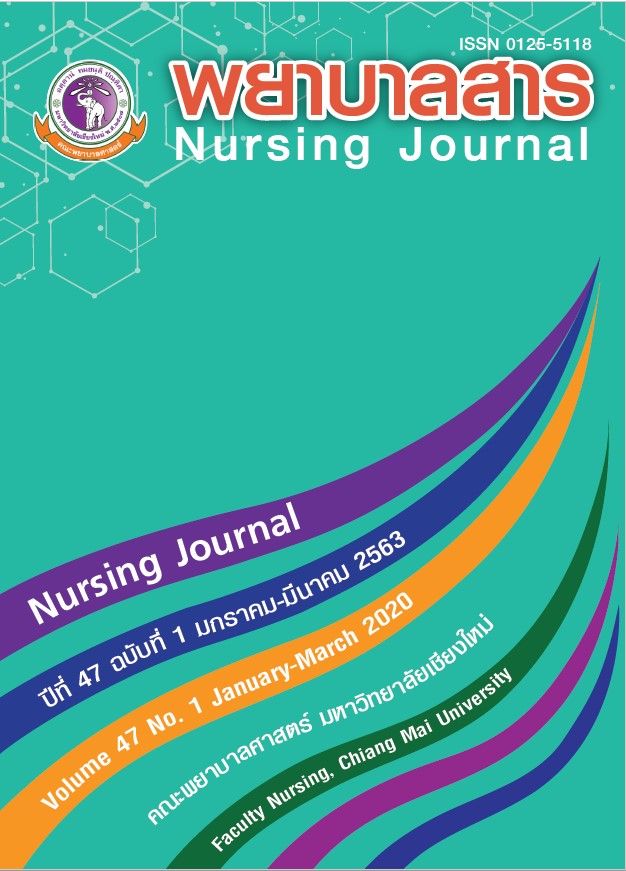บรรยากาศการทำงานและความตั้งใจลาออกของพยาบาล ในโรงพยาบาลระดับตติยภูมิ สาธารณรัฐแกมเบีย
คำสำคัญ:
บรรยากาศการทำงาน, ความตั้งใจในการหมุนเวียน, พยาบาล, โรงพยาบาลระดับตติยภูมิ, แกมเบียบทคัดย่อ
บรรยากาศการทำงานเป็นปัจจัยสำคัญในการทำนายการลาออกจากงานของพยาบาลซึ่งสามารถประเมินได้จากความตั้งใจในการลาออกจากงาน การศึกษาครั้งนี้มีวัตถุประสงค์เพื่อศึกษาระดับของบรรยากาศการทำงาน ความตั้งใจลาออก และหาความสัมพันธ์ระหว่างบรรยากาศการทำงานและความตั้งใจลาออกของพยาบาลในโรงพยาบาลระดับตติยภูมิจำนวน 6 แห่ง สาธารณรัฐแกมเบีย กลุ่มตัวอย่างประกอบด้วยพยาบาลวิชาชีพจำนวน 201 คน ที่ได้รับการคัดเลือกแบบสุ่มจากแผนกต่างๆ ในโรงพยาบาลระดับตติยภูมิ 6 แห่ง เครื่องมือที่ใช้ในงานวิจัยประกอบด้วย แบบบันทึกข้อมูลส่วนบุคคล แบบสอบถามบรรยากาศทางจิตวิทยา CRISO (CRISO-PCQ) และแบบวัดความตั้งใจในการลาออกจากงาน (Turnover Intention Scale: TIS) ค่าความเที่ยงตรงของแบบสอบถาม CRISO และแบบสอบถาม TIS ได้รับการยืนยันจากผู้พัฒนาเครื่องมือ ค่าความเชื่อมั่นของแบบสอบถามบรรยากาศทางจิตวิทยา CRISO เท่ากับ 0.92 และแบบวัดถามความตั้งใจในการลาออกจากงานเท่ากับ 0.80 วิเคราะห์ข้อมูลโดยใช้สถิติเชิงพรรณนาและสถิติสหสัมพันธ์ของเพียร์สัน
ผลการศึกษาในครั้งนี้มีดังนี้
- ระดับของบรรยากาศการทำงานตามการรับรู้ของพยาบาลโดยรวมพบว่าเป็นบวก และระดับของมิติ 15 ด้านของบรรยากาศการทำงาน พบว่าเป็นผลบวก 9 ด้าน และเป็นลบ 6 ด้าน
- ระดับของความตั้งใจลาออกโดยรวมตามการรับรู้ของพยาบาลพบว่าอยู่ในระดับสูง
- บรรยากาศการทำงานโดยรวมและ 13 ด้านมีความสัมพันธ์ทางลบอย่างมีนัยสำคัญทางสถิติกับความตั้งใจลาออก แต่พบว่าบรรยากาศการทำงาน 2 ด้านไม่พบความสัมพันธ์กับความตั้งใจลาออก
ผลการศึกษาในครั้งนี้ ผู้บริหารทางการพยาบาลในสาธารณรัฐแกมเบียสามารถนำไปใช้ในการพัฒนากลยุทธ์ในการปรับปรุงบรรยากาศการทำงานในด้านลบเพื่อที่จะช่วยลดความตั้งใจลาออกในโรงพยาบาลระดับตติยภูมิทั้ง 6 แห่งในการศึกษาครั้งนี้
References
Africa Health Observatory. (2012). The Gambia country profile: Analytical summaries. In Banjul (author). American Association of Colleges of Nursing: Nursing shortage fact sheet. Washington, DC: Africa Health Observatory.
American Bureau of Labor Statistics. (2010). Nursing shortage fact sheet. New York: The Center for Health Workforce Studies.
Arnold, J. H., & Feldman, A. D. (1982). Multivariate analysis of the determinants of job turnover. Journal of Applied Psychology, 67 (3), 350-360. doi:10.1037/0021-9010.67.3.350
Bedi, A., Courcy, F., Paquet, M., & Harvey, S. (2012). Interpersonal aggression and burnout: The mediating role of psychological climate. Stress and Health, 29 (5), 350-359. doi:10.1002/smi.2476
Biswas, S. (2010). Relationship between psychological climate and turnover intentions and its impact on organisational effectiveness: A study in Indian organ isations. IIMB Management Review, 22(3), 102-110. doi:10.1016/j.iimb.2010.04.013
Burns, N., & Grove, K. S. (2005). The practice of nursing research conduct, critique, and utilization. Philadelphia: W. B. Saunders.
Clark, P. F., & Clark, D. A. (2006). Union strategies for improving patient care: The key to nurse unionism. Labor Studies Journal, 31 (1), 51-70. doi:10.1353/lab.2006.0003.
Du Plooy, J., & Roodt, G. (2013). Biographical and demographical variables as moderators in the prediction of turnover intentions. SA Journal of Industrial Psychology, 39 (1), 1-12. doi:10.4102/sajip.v39i1.1070
Dywili, M. (2015). The relationship between occupational stress and intentions to quit amongemployees at Nkonkobe Municipality, South Africa. Business and Economics Journal, 6 (2),146-156. doi:10.4172/2151-6219.1000146.
Fishbein, M., & Ajzen, I. (1975). Belief, attitude, intention, and behavior: An introduction to theory and research. Reading, MA: Addison-Wesley.
Gagnon, S., Paquet, M., Courcy, F., & Parker, C. P. (2009). Measurement and management of work climate: Cross-validation of the CRISO Psychological Climate Questionnaire. Healthcare Management Forum, 22(1), 57-65.
Clissold, G. C. (2006). Psychological climate: what is it and what does it look like?. In Australian Centre for Research in Employment and Work (ACREW) Conference (pp. 1-25). Events Management Office, Monash University.
Gormley, D. K., & Kennerly, S. (2011). Predictors of turnover intention in nurse faculty. Journal of Nursing Education, 50 (4), 190-196. doi:10.3928/01484834-20110214-05.
Human Resource for Health. (2009). Human Resources for Health country profile: The Gambia. Banjul: Human Resource for Health.
Hwang, J. I., & Chang, H. (2009). Work climate perception and turnover intention among Korean hospital staff. International Nursing Review, 56 (1), 73-79. doi:10.1111/j.1466-7657.2008.00641.x
Jacobs, E. J., & Roodt, G. (2011). The mediating effect of know ledge sharing between organisational culture and turnover intentions of professional nurses. South African Journal of Information Management, 13(1), 1-6.
Jones, A. P., & James, L. R. (1979). Psychological climate dime nsions and relationships of individual and aggregated work environment perception. Organizational Behavior and Human Performance, 23 (2), 201-250. doi:10.1016/0030-5073(79)90056-4
Martin, A., & Roodt, G. (2008). Perception of organisational commitment, job satisfaction and turnover intentions in a post-merger South African tertiary ins titution. SA Journal of Industrial Psychology, 34 (1), 23-31. doi:10.4102/sajip.v34i1.415.
Masemola, S. E. (2011). Employee turnover intentions, organizational commitment, and jobsatisfaction in post-merger tertiary institutions (Master’s thesis, University of Lumpopo).
Ministry of Health and Social Welfare. (2009). National health research policy 2010-2014.Banjul: Ministry of Health and Social Welfare.
Ministry of Health and Social Welfare. (2012c). The Gambia national health strategic plan2014-2020. Banjul: Ministry of Health and Social Welfare.
Mishra, S., & Bhatnagar, D. (2010). Linking emotional dissonance and organisational identification to turnover intention and emotional well-being: A study of medi cal representatives in India. Human Resource Management, 49 (3), 401-419. doi:10.1002/hrm.20362
Mobley, W. H. (1982). Employee turnover: Causes, consequences and control. MA: Addison-Wesley.
Mobley, W. H., Griffeth, R. W., Hand, H. H., & Meglino, B. M. (1979). Review and conceptual analysis of the employee turnover process. Psychological Bulletin, 86 (3), 493-522.
O’Brien-Pallas, L., Murphy, G. T., Shamian, J., Li, X., & Hayes, L. T. (2010). Impact and determinants of nurse turnover: A pan-Canadian study. Journal of Nursing Management, 18 (8), 1073-1086. doi:10.1111/j.1365-2834.2010.01167.x
Raphael, T. (2015). Nurse turnover in hospitals. Retrieved from http://www.ere.net/nurse-turnover-in-hospitals.html
Roodt, G. (2004). Turnover intentions. South Africa: University of Johannesburg.
Roussel, L., Swansburg, R. C., & Swansburg, R. L. (2006). Management and Leadership for nurse administrators. Boston: Jones and Bartlett.
Sullivan, E. J., & Decker, P. J. (2005). Reducing turnover, retaining staff, effective leadership &management in nursing (6 th ed.). New Jersey: Person Education.
Verbeke, W., Volgering, M., & Hessels, M. (1998). Exploring the conceptual expansion within the field of organizational behaviour: Organizational climate and organizational culture. Journal of Management Studies, 35(3), 303-329. doi:10.1111/1467-6486.00095
World Bank. (2006). World Bank annual report. Washington, DC: World Bank Press Kid.
World Bank. (2010). World Bank annual report. Washington, DC: World Bank Press Kid.
World Bank, Africa Region. (2010). The Gambia Improving Civil Service Performance. Washington, DC: Department for International Development.
World Health Organization. (2006). Working together for health. Geneva: World Health Organization.
Yousef, H. R., Abo El-Maged, N. S., & El-Houfey, A. A. (2014). Organizational climate correlates nurses’ intention to leave. Public Policy and Administration Research, 4 (4), 14-21.
Downloads
เผยแพร่แล้ว
How to Cite
ฉบับ
บท
License
บทความที่ได้รับการตีพิมพ์เป็นลิขสิทธิ์ของวารสารพยาบาลสาร
ข้อความที่ปรากฏในบทความแต่ละเรื่องในวารสารวิชาการเล่มนี้เป็นความคิดเห็นส่วนตัวของผู้เขียนแต่ละท่านไม่เกี่ยวข้องกับมหาวิทยาลัยเชียงใหม่ และคณาจารย์ท่านอื่นๆในมหาวิทยาลัยฯ แต่อย่างใด ความรับผิดชอบองค์ประกอบทั้งหมดของบทความแต่ละเรื่องเป็นของผู้เขียนแต่ละท่าน หากมีความผิดพลาดใด ๆ ผู้เขียนแต่ละท่านจะรับผิดชอบบทความของตนเองแต่ผู้เดียว





